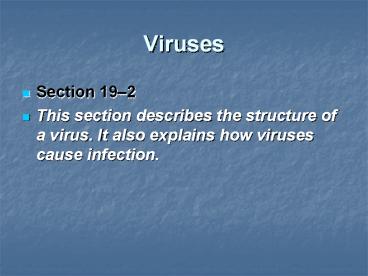Viruses - PowerPoint PPT Presentation
Title:
Viruses
Description:
The cell transcribes and translates the viral genetic information into viral capsid proteins. Sometimes the program may cause the cell to make copies of the virus, ... – PowerPoint PPT presentation
Number of Views:26
Avg rating:3.0/5.0
Title: Viruses
1
Viruses
- Section 192
- This section describes the structure of a virus.
It also explains how viruses cause infection.
2
What Is a Virus?
- What are Viruses?
- They are particles of nucleic acid, protein, and
in some cases lipids that can reproduce only by
infecting living cells.
3
What do all viruses have in common?
- They enter living cells and, once inside, use the
machinery of the infected cell to produce more
viruses.
4
Is the following sentence true or false?
- Most viruses are so small that they can be seen
only with the aid of a powerful electron
microscope. - True
5
What Is a Virus?
- What is the structure of a typical virus?
- A typical virus is composed of a core of either
DNA or RNA surrounded by a protein coat.
6
What Is a Virus?
- Circle the letter of what a viruss protein
coat is called. - capsid
7
What Is a Virus?
- How does a typical virus get inside a cell?
- The capsid proteins bind to receptors on the
surface of a cell and trick the cell into
allowing it inside.
8
What Is a Virus?
- What occurs when viruses get inside of cells?
- Once inside, the viral genes are expressed. The
cell transcribes and translates the viral genetic
information into viral capsid proteins. Sometimes
the program may cause the cell to make copies of
the virus, and in the process the host cell is
destroyed.
9
What Is a Virus?
- Why are most viruses highly specific to the cells
they infect?
10
What Is a Virus?
- Viruses must bind precisely to proteins on the
cell surface and then use a hosts genetic system.
11
What Is a Virus?
- What are bacteriophages?
- They are viruses that infect bacteria. Viral
Infection
12
What Is a Virus?
- Why is a lytic infection given that name?
- The host cell is lysed and destroyed.
13
What Is a Virus?
- Circle the letter of each sentence that is true
about a lysogenic infection. - The virus embeds its DNA into the hosts DNA.
14
What Is a Virus?
- The viruss DNA is replicated along with the host
cells DNA. - A host cell makes copies of the virus
indefinitely.
15
Complete the flowchart about a lytic infection.
16
What Is a Virus?
- What is prophage?
- It is the viral DNA that is embedded in the
hosts DNA.
17
What Is a Virus?
- Retroviruses
- What are retroviruses?
- They are viruses that contain RNA as their
genetic information.
18
What Is a Virus?
- What happens when retroviruses infect a cell?
- They produce DNA copy of their RNA. This DNA is
inserted into the DNA of the host cell.
19
What Is a Virus?
- Viruses and Living Cells
- Circle the letter of each reason why some
biologists do not consider viruses to be alive. - They cant reproduce independently.































